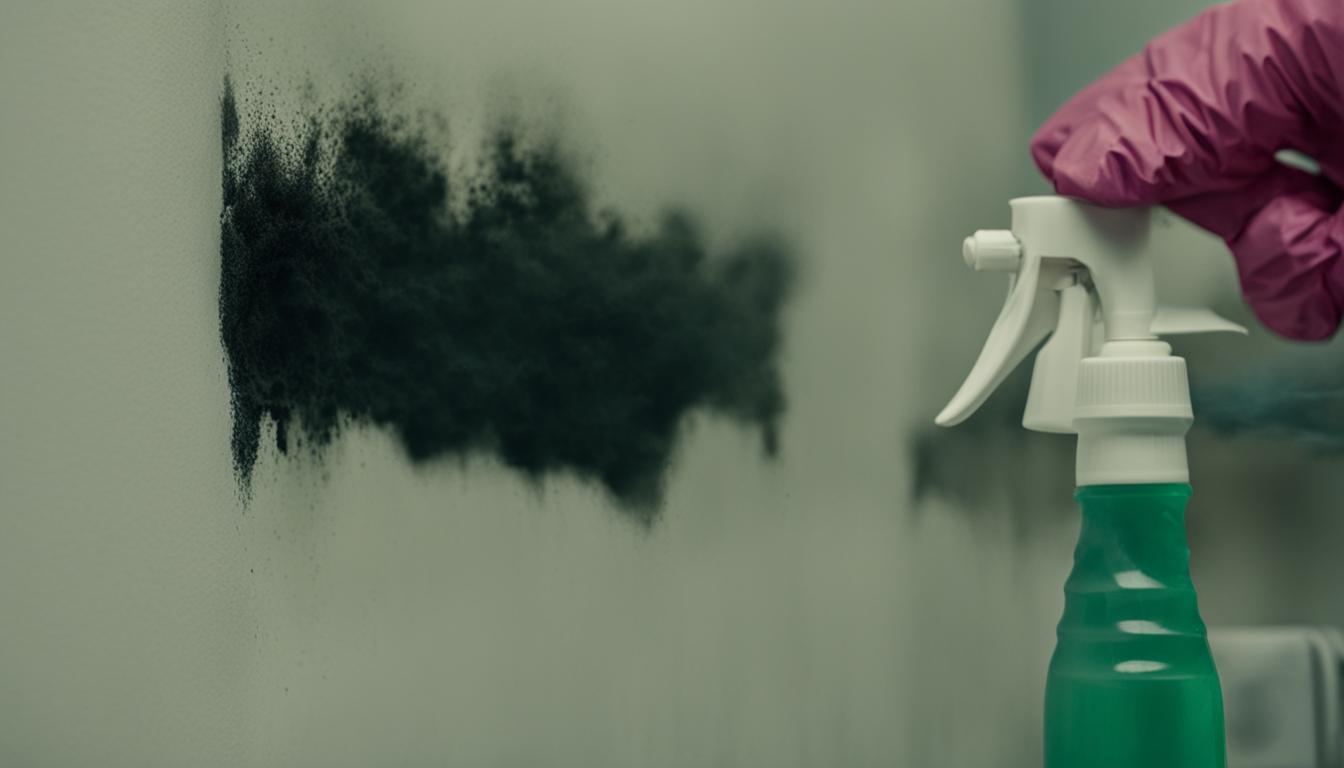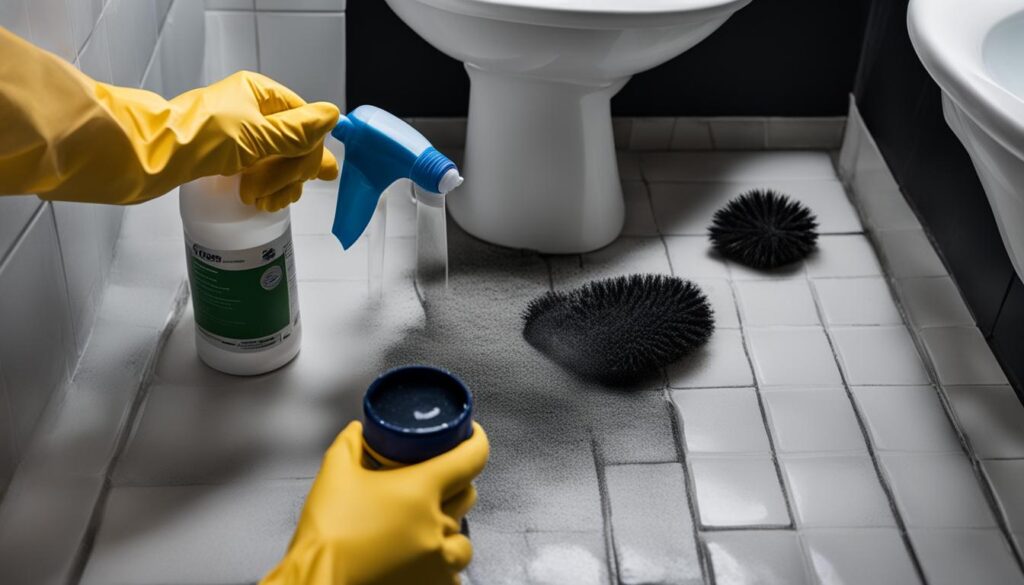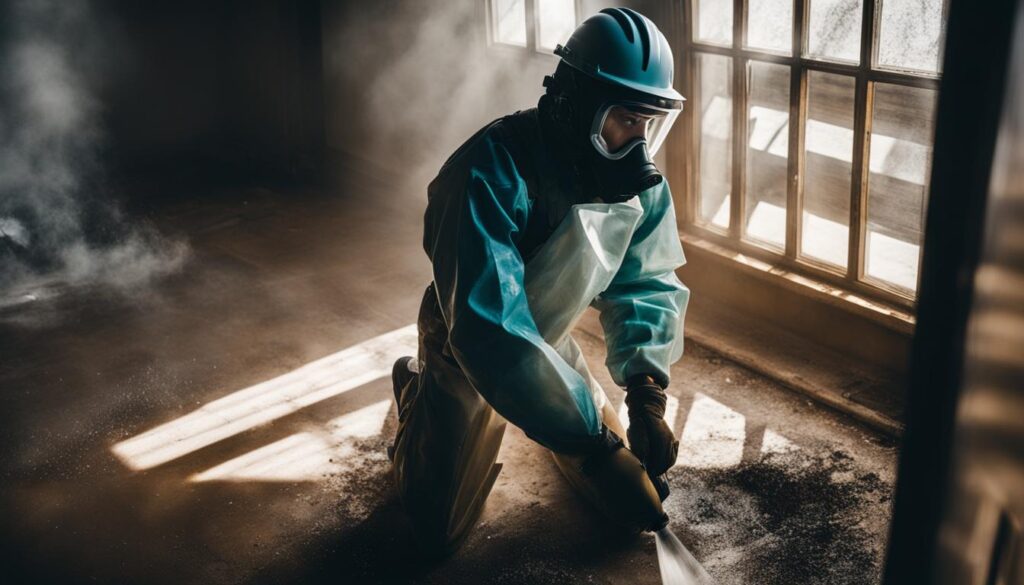
Ultimate Guide to Clean Black Mold Safely & Easily
Welcome to the ultimate guide on how to clean black mold from your home safely and easily. Black mold can be a persistent and harmful problem, but with the right techniques, you can effectively remove it and ensure a mold-free environment for you and your family.
In this comprehensive guide, we will provide you with expert tips and methods for black mold removal. Whether you choose to tackle the cleaning yourself or hire professionals, we have you covered. Let’s dive in and learn the best practices for eliminating black mold and creating a healthy living space.
Key Takeaways:
- Black mold can pose health risks and should be addressed promptly
- Proper identification of black mold is crucial for effective removal
- Safe and effective DIY techniques can be used for manageable mold problems
- Hiring professionals may be necessary for extensive mold infestations
- Preventing moisture and improving ventilation can help prevent future mold growth
Understanding Black Mold and its Risks
Before we dive into the cleaning process, it’s important to understand what black mold is and the potential risks it poses. Black mold, also known as Stachybotrys chartarum, is a type of toxic mold that can grow in homes with excessive moisture. It thrives in damp and dark environments, such as bathrooms, basements, and areas affected by water damage.
Black mold is characterized by its dark greenish-black appearance and slimy texture. It releases spores into the air, which can cause various health problems when inhaled or touched. Exposure to black mold can lead to respiratory issues, allergies, skin irritation, and even more severe symptoms for individuals with weakened immune systems.
Preventing the growth of black mold is crucial to ensuring a healthy living environment. There are several steps you can take to minimize the risk of mold infestation in your home:
- Maintain proper ventilation throughout your home to reduce moisture levels. Use exhaust fans in bathrooms and kitchens, and open windows when weather permits.
- Repair any leaks or water damage promptly. Check for and fix any plumbing issues, roof leaks, or foundation cracks that may contribute to moisture buildup.
- Monitor indoor humidity levels using a hygrometer. The optimal humidity range is between 30% and 50%. Consider using a dehumidifier in areas prone to excess moisture, such as basements.
- Ensure proper insulation and airflow in your home. Insulate exterior walls and windows to prevent condensation and moisture buildup.
- Regularly clean and dry areas that are prone to moisture, such as bathrooms, kitchens, and laundry rooms. Use mold-resistant cleaning products and ensure surfaces are completely dry after cleaning.
By implementing these preventive measures, you can significantly reduce the risk of black mold growth in your home. However, if you do encounter a black mold infestation, it’s essential to take immediate action to remove it safely and effectively.
Identifying Black Mold in Your Home
Knowing how to identify black mold is crucial for effective removal. Taking prompt action is essential to prevent further damage and protect the health of you and your family. In this section, we will guide you through the process of identifying black mold in different areas of your home. By being able to distinguish between regular mold and black mold, you can ensure proper cleaning and take the necessary steps to address the issue.
Signs of Black Mold
Black mold, also known as Stachybotrys chartarum, typically appears as black or dark green patches with a slimy or fuzzy texture. It is commonly found in areas with excess moisture, such as bathrooms, basements, and kitchens. When it comes to identifying black mold, keep an eye out for the following signs:
- Distinctive Coloring: Black or dark green patches on walls, ceilings, or other surfaces.
- Musty Odor: A strong, unpleasant odor similar to damp or rotten wood.
- Water Damage: Evidence of leaks, water intrusion, or past flooding.
- Health Issues: Symptoms like respiratory problems, allergies, or persistent coughing in the presence of mold.
Differentiating Black Mold from Regular Mold
While black mold is a type of mold, not all molds are black mold. It’s important to distinguish between the two to determine the best course of action. Here are some key differences:
| Black Mold | Regular Mold |
|---|---|
| Typically black or dark green in color | Usually green, white, or gray |
| Has a slimy or fuzzy texture | Can have a powdery or downy texture |
| Produces a musty odor | May have a mild or no noticeable odor |
| Commonly associated with water damage and high moisture levels | Can grow in various environments with different moisture levels |
If you suspect that black mold is present in your home, it’s advisable to consider professional black mold removal services, especially if the affected area is large or difficult to access. Professionals have the expertise and specialized equipment to safely remove black mold and ensure its complete elimination.

Safe and Effective DIY Mold Removal Techniques
When you’re dealing with a manageable black mold problem in your home, there are safe and effective DIY techniques that you can use to remove it. By following these step-by-step instructions and utilizing household cleaning products, natural remedies, and proper protective gear, you can safely eliminate black mold from your surroundings.
Step 1: Gather the Necessary Supplies
Before you begin the mold removal process, make sure you have the following items:
- Protective clothing, including gloves, goggles, and a face mask
- Mold-specific cleaning products or a mixture of vinegar and water
- A scrub brush or sponge
- A plastic bag or garbage bag for disposal
- A dry cloth or towel
Step 2: Protect Yourself
Prioritize your safety by wearing the appropriate protective gear. This includes gloves to protect your hands, goggles to shield your eyes, and a face mask to prevent inhalation of mold spores.
Step 3: Ventilate the Area
Open windows and doors or use fans to increase air circulation in the affected area. This will help remove any lingering mold spores and reduce the risk of exposure.
Step 4: Clean the Moldy Surface
To remove black mold, choose a mold-specific cleaning product or create a solution of equal parts vinegar and water in a spray bottle. Apply the cleaning solution to the moldy surface and let it sit for a few minutes to loosen the mold.
Using a scrub brush or sponge, gently scrub the moldy area in a circular motion. Be thorough and ensure you reach all the hidden corners. Rinse the area with clean water and wipe it dry with a cloth or towel.
Step 5: Dispose of Contaminated Materials
Place any mold-infested materials, such as carpets or fabric, in a plastic bag or garbage bag for safe disposal. Seal the bag tightly to prevent the spread of mold spores.
Step 6: Prevent Future Mold Growth
After successfully removing the black mold, take preventive measures to avoid its recurrence. Keep the area well-ventilated, control moisture levels, and fix any plumbing or water issues promptly. Regularly clean and inspect your home for signs of mold growth to address it early on.

By following these safe and effective DIY mold removal techniques, you can address black mold in your home and create a healthier living environment.
Hiring Professionals for Black Mold Removal
In cases where the black mold infestation is extensive or if you’re unsure about handling it yourself, it’s best to hire professionals for mold removal. Attempting to clean up severe black mold contamination without the proper expertise and equipment can pose significant health risks. Professional mold remediators have the knowledge, experience, and specialized tools necessary to ensure a thorough and effective removal process.
When hiring professionals for black mold removal, look for reputable companies with a track record of success in dealing with mold infestations. Consider the following factors:
- Experience: Choose a company that has extensive experience in black mold removal. They should be well-versed in the latest techniques and industry standards.
- Certifications and Licenses: Verify that the mold removal professionals hold relevant certifications and licenses. This ensures they have undergone proper training and adhere to industry regulations.
- Insurance: It is crucial to hire a company that carries liability insurance. This protects you from any potential damage or accidents that may occur during the remediation process.
- References and Reviews: Check for references from previous clients or read reviews to gauge customer satisfaction and the quality of their work.
- Guarantee: A reputable mold removal company should provide a guarantee on their services to give you peace of mind that the job will be done effectively.
Professionals adopt the best mold removal methods to eliminate black mold completely. These methods may include:
- Isolation: Professionals use containment measures to prevent mold spores from spreading to unaffected areas of your home during the removal process.
- Filtration: High-efficiency particulate air (HEPA) filters are used to capture and remove mold spores from the air, ensuring a safer environment.
- Removal: The professionals will safely remove all affected materials that cannot be salvaged, such as drywall, insulation, or carpeting.
- Cleaning: They will thoroughly clean all surfaces using specialized cleaning agents to eliminate any remaining mold spores.
- Drying and Preventive Measures: Professionals will dry the affected areas and apply preventive treatments to inhibit mold growth in the future.
Image:
Preventing Black Mold Growth in the Future
Now that you’ve successfully eliminated black mold from your home, it’s crucial to implement preventive measures to avoid future growth. Taking proactive steps can help you maintain a mold-free environment and ensure the health and safety of your living spaces.
Reducing Moisture
Moisture is one of the main factors contributing to mold growth. To prevent mold from reappearing, address any moisture-related issues promptly:
- Fix any leaks or water damage in plumbing, roofs, or windows.
- Monitor indoor humidity levels and keep them below 60%. Consider using dehumidifiers in areas prone to high humidity.
- Use exhaust fans in the bathroom and kitchen to reduce moisture accumulation.
- Avoid overwatering indoor plants and ensure proper drainage.
Improving Ventilation
Proper air circulation plays a crucial role in preventing mold growth. Follow these tips to improve ventilation in your home:
- Open windows regularly to let fresh air in and improve airflow.
- Ensure that air vents and ductwork are clean and unobstructed.
- Use ceiling fans or portable fans to enhance air circulation.
- Avoid blocking vents with furniture or other objects.
Maintaining a Mold-Free Environment
Consistent maintenance practices can help you keep mold at bay. Implement these habits to maintain a mold-free environment:
- Regularly clean and dry areas prone to moisture, such as bathrooms, kitchens, and basements.
- Inspect and clean air conditioning units, filters, and drip pans regularly.
- Remove and replace mold-affected materials such as carpets, wallpaper, and ceiling tiles.
- Regularly vacuum and clean your home to remove dust and allergens that could contribute to mold growth.
By following these preventive measures, you can greatly reduce the risk of black mold returning to your home. Stay vigilant, address moisture issues promptly, and maintain good airflow to create an environment that is inhospitable to mold growth.
Remember, prevention is key to ensuring a healthy and mold-free living space for you and your loved ones.
Conclusion
In this comprehensive guide, we have provided you with the safest and most efficient techniques for cleaning black mold. Whether you decide to tackle the removal yourself or seek professional help, prompt action is crucial for preventing further damage and protecting your health.
If you have any further questions or require professional assistance, contact Fix Mold Miami at 305-465-6653. Our team of experts is ready to help you restore a mold-free and healthy home environment.
Remember, maintaining a mold-free home requires ongoing vigilance. Regularly inspect your property for signs of moisture and address any issues promptly to prevent mold growth. By taking preventive measures and implementing the techniques discussed in this guide, you can ensure the long-term well-being of your home and your loved ones.




